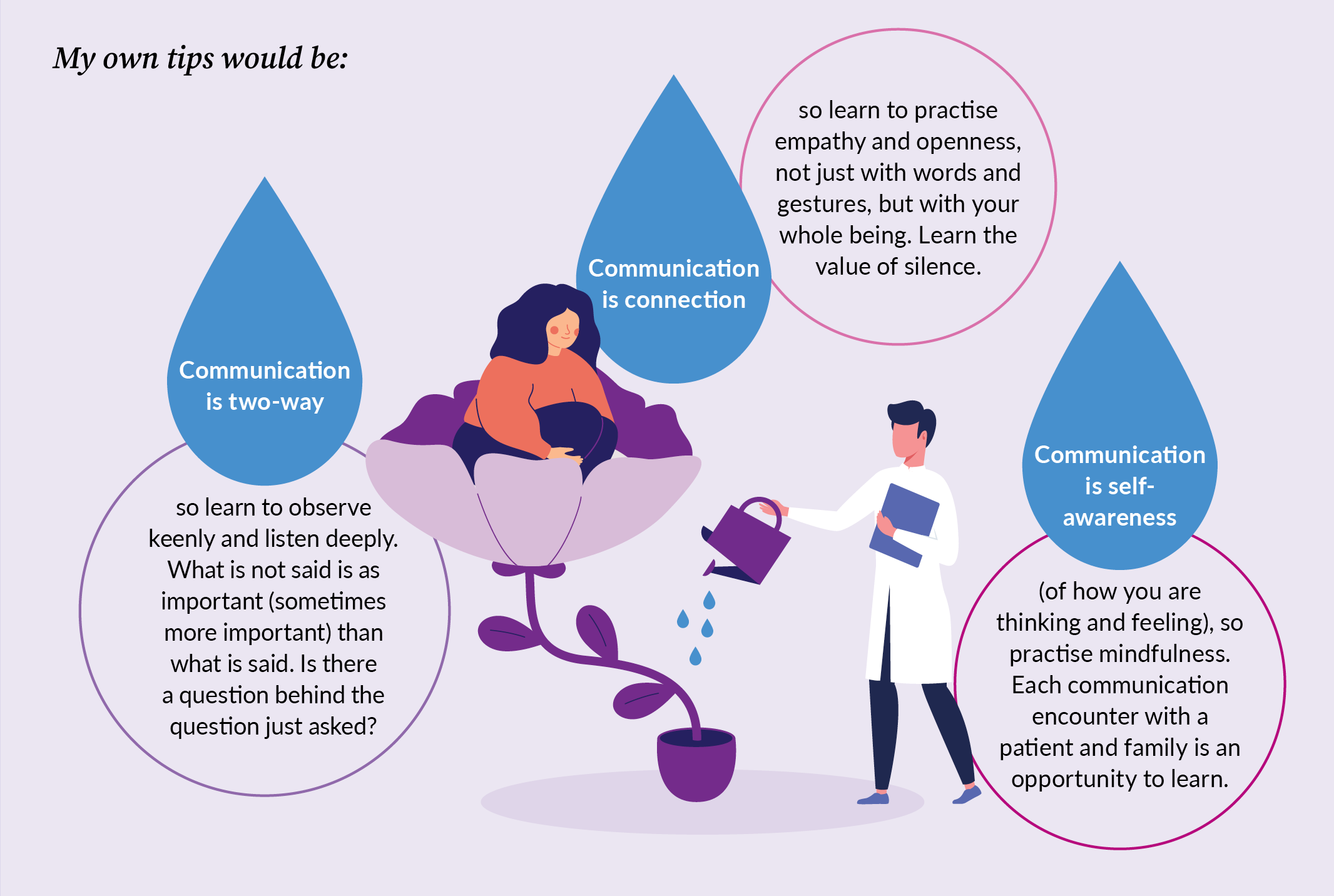
Issue 46
May 2023
THE LAST MILE
by Dr Noreen Chan, Head and Senior Consultant, Division of Palliative Medicine, National University Cancer Institute, Singapore

In healthcare, doctors and other healthcare professionals sometimes need to convey bad news to patients and families. It has been so for hundreds of years, for as long as the healing professions have existed. But it may surprise you to know that formal communication skills training for healthcare workers is a much more recent development.
I certainly was not taught how to communicate as an undergraduate nor as a junior doctor (which was a long time ago, many more years than I care to admit). Somehow we were expected to learn on the job, a case of communication skills being “caught” rather than taught.
I am embarrassed to recall the many mistakes I made along the way, but each stumble or blunder was also an important lesson, as was every observed encounter between a senior colleague and patient/family. Two incidents come to mind: when I was a house officer in surgery, one of the patients in the ward was a man who had come in with abdominal pain and after a series of tests, had been diagnosed with advanced colon cancer.
During the morning ward round, it transpired that the patient had not yet been told the news, because the test results had only been available the previous evening. The medical officer and I looked at each other and our long list of patients, wondering who would volunteer for the task, when the registrar said, “I’ll talk to him, you carry on with the round and I will catch up.” As we dashed off with a sense of relief, I glanced back and I saw him pulling a chair up to the patient’s bedside and drawing the curtains. It occurred to me that what he was going to say to that man would change his life forever.
The second incident is from my time as a medical officer posted to the Emergency Department. One day a man was brought in. He had collapsed at the hawker centre, and despite our efforts did not survive. When his wife—now widow—arrived, I was asked to bring her to the “Quiet Room” to view the body. I knew the senior doctor in charge of our shift had spoken to her, so it was puzzling when she started peppering me with questions and comments like “How can it be? He’s still warm! Look he is moving, I can see his chest moving”
It is not just about telling the news, it is about dealing with the aftermath of 'dropping the bomb'.”
I ended up using my stethoscope to let her hear her own heartbeat, then I placed the bell on the patient’s chest so that she could hear that it was totally silent. She went quiet and I thought, aha! she finally gets it. So I was completely unprepared when she suddenly started wailing and crying, beating her fists on her dead husband’s body and shaking the trolley rails. I had never witnessed acute grief like that before, and I was literally stunned. Fortunately, a kindly nurse came by and rescued me, and as I beat a hasty retreat, I once again glanced back and saw her put her arms around the shoulders of the grieving widow.
So it is not just about telling the news, it is about dealing with the aftermath of “dropping the bomb”.
These days, communications workshops and courses are common, and we have established tips and approaches that are widely taught. One of the best known is the SPIKES Protocol1.
This is how the mnemonic SPIKES can be interpreted:
Set-Up
Find a quiet private space, preferably somewhere everyone can be seated.
Perception
What does the patient/family already know or suspect?
Invitation
What does the patient/family want to know? Should we be detailed and blunt, or go “bit by bit”?
Knowledge
Deliver the information in bite-sized pieces, checking understanding along the way. This is sometimes known as “Tell-Ask-Tell”.
Empathy
Respond to emotions and provide support.
Strategy
and Summary
Sum-up what has been said, including any plans and “next steps”.
The elegance of the approach is its simplicity; it is easy to understand and the principles can be widely applied. But of course, theory is one thing, application and practice something else altogether.
For example, how to deliver the information simply and effectively. A good strategy is “the warning shot”, a short statement that warns listeners to brace themselves for what is coming, for example, “I’m afraid the result is serious”. Then the news should follow, ideally using simple straightforward language, which is harder than you think. Doctors do have a tendency to want to deliver a lot of information, perhaps because they want to ensure full understanding, or because they want to lead up gradually to the main facts. But this may result in the patient and family’s attention being scattered and the conversation losing focus, such that the main messages are not properly understood.
I think there is no one right way, there are better ways and worse ways. But ultimately, it has to be patient- and family-centred. Conveying bad news is like giving bitter medicine; it is done with a purpose and with best intentions, but has to be 'dosed' correctly for the best effect.”
Next, the topic of Empathy, which is the capacity to understand or feel what another person is experiencing from within their frame of reference; in other words, being able to walk in their shoes. Empathy is crucial in building rapport and trust, and I have even heard a hostage negotiator use the term “tactical empathy”. Many communications courses teach “micro-skills” which help to convey empathy, some verbal e.g. naming emotions, phrases like “tell me more”, and some non-verbal i.e. using body language like nodding, leaning forward etc. These skills are important, but empathy is not just going through the motions, it is making a meaningful connection with the person(s) you are speaking to.
Many doctors find it stressful to convey bad news because of the emotions involved, and of course emotional situations are uncomfortable. It is natural to avoid what is awkward and uncomfortable: therefore many of us may respond to the other party’s emotional cues by …. not responding to them! We use avoidance, deflection, distraction, downplaying or any number of strategies to get the conversation over and done with. Most of the time, we are not even aware we are doing it. But the danger with not acknowledging the emotional response, is that people may feel they have not been fully heard.
Finally, it must be emphasised that communication is two-way. It is a common mistake that we are so preoccupied with getting our message across, we forget to “tune into” the other party’s message(s), and then wonder why we are not on the same wavelength. We need to listen actively, not just to what is said, but also to what is unsaid and “below the surface”. I have learnt not to take questions and statements at face value, and will often ask to clarify e.g. “what do you mean?”, “why did you say that?” etc.
So, is there a right way to deliver bad news? I think there is no one right way, there are better ways and worse ways. But ultimately, it has to be patient- and family-centred. Conveying bad news is like giving bitter medicine; it is done with a purpose and with best intentions, but has to be “dosed” correctly for the best effect.
The good news is that communication skills can be learnt and improved upon.

A woman decides to take a well-earned vacation and asks her brother to watch her cat while she’s away.
On the second day, when she calls her brother to see how things are going he tells her bluntly that the cat is dead.
The woman is really upset and goes into hysterics, before saying, “You can’t tell a person bad news so bluntly. You should break the news gently. The first day, you should have said that Fluffy was stuck on the roof and couldn’t get down. The second day, you could have said that she had fallen, but the vet said she would be okay. Then on the third day you could have said that she died from complications.”
The next day, the woman calls her brother again and asks how things are. He says, “Well, Grandma is stuck on the roof and can’t get down…”
WF Baile, R Buckman et al. SPIKES—A Six‐Step Protocol for Delivering Bad News: Application to the Patient with Cancer
https://theoncologist.onlinelibrary.wiley.com/doi/full/10.1634/theoncologist.5-4-302.
More from this issue

PEOPLE OF NUS MEDICINE
Artist Behind the Art: Med Student Goes Viral with His Dystopian Cityscapes


